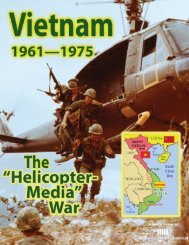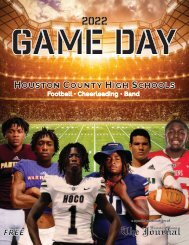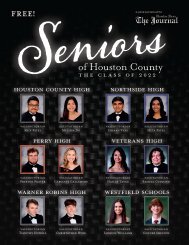Create successful ePaper yourself
Turn your PDF publications into a flip-book with our unique Google optimized e-Paper software.
The Greatest Generation
of Houston County
A Special Publication by
HHJ
Houston Home Journal
The Shaheen &
Kiefer families
would like to
recognize
and honor those
who unselfishly
served our
country
In memory of
Chuck Shaheen, Jr.
Arthur Kiefer
Tom Martinez
WWII
Veterans
of Houston
County
PUBLISHER
Cheri Adams
cadams@hhjnews.com
MANAGING EDITOR
Kristin Moriarty
kristinm@hhjnews.com
Contents
Editorial Content
6 Tales from WWII
8 History of Warner Robins Air Force Base
10 The War Room at Perry Historical Society
14 The Home Front During WWII
16 Remembering Pearl Harbor
Veterans
7 E.J. Potenziani & George Mayo
9 Henry Les Goggans & Ernest Wood
12 Bob Keefner & Richard Twining
13 John Manning & Edward Krout
15 Charles Tyler & Victor Nicoletti
17 Samuel O-Quin & Crawford Hicks
18 Donald Garrett & Penrose Wolf
19 Keath Morgan & Ralph N. Pannell
23 John Knowles & James Brown
ADVERTISING
Lori Kovarovic
lorik@hhjnews.com
Nathan Mathis
nmathis@hhjnews.com
WRITERS
Jada Dukes
jdukes@hhjnews.com
Madeline Maynor
Ellie Loudermilk
GRAPHIC DESIGN
Devyn Mode
production@hhjnews.com
Jordan Pridgeon
production@hhjnews.com
PHOTOGRAPHY
Cheri Adams
Kristin Moriarty
Jada Duke
Madeline Maynor
Published by
HOUSTON
Publications,
Incorporated
1210 Washington Street
P.O. Box 1910
Perry, GA 31069
Phone: 478-987-1823
www.hhjonline.com
Thank You for Your Service!
Jillinda Falen
REALTOR ®
Estate Liquidation Specialist
Office: (478) 224-9980
Cell: (478) 396-4802
jcfalen@gmail.com
www.jillindafalen.com
902 Northside Dr. • Perry, GA 31069
SSG Stilley, William
Veteran Owned
Conveniently
located just off 1-75 exit 136
1369 Sam Nunn Blvd
Perry Marketplace
Next to Kroger in Perry
Visit Our Drive Thru
Photo By: Keira Davis Photography
Come celebrate life’s special
events with us!
Weddings • Receptions • Meetings • Parties & More!
1000 Country Club Rd. Perry 478•224•4653
cherokeepines.com
PERRY DRUG COMPANY
Your Hometown, Family Owned Pharmacy
www.PerryDrugCompany.com
1036 Macon Rd | Perry GA | 478-988-1144
THANK YOU
★★★★★★★★★
{ For your service, sacrifice and patriotism }
151074
“We’ve Got Your 6!” Originated in WWI among
fighter pilots and it means “We’ve Got Your Back!”
“I’ve Got Your 6” refers to watching out for fellow soldiers
at an angle they cannot cover themselves.
We would like all of our local Veterans to know
“We’ve Got Your 6!”
1365 Sam Nunn Blvd., Perry, GA 31069 478-224-ribs (7427)
www.shanesribshack.com
151180
Ed & Vera Bayer.
Ed Bayer, World
War II Veteran,
founded Warner
Robins Building
Supply in 1947.
Warner Robins
2756 Watson Boulevard
478-953-4100
Perry
612 Ball Street
478-987-2334
Page 6
Tales from WWII
Tales from WWII
This magazine is dedicated
to the brave men and
women of Houston County
who served in World War II.
We appreciate the sacrifices
you made and the dedication
to this country.
There are so many who paid
the ultimate price, it’s a debt
we can never fully repay.
You are truly the Greatest
Generation!
“Veterans know better than
anyone else the price of freedom,
for they’ve suffered the
scars of war. We can offer
them no better tribute than to
protect what they have won
for us.”
- President Ronald Reagan,
1983, in a radio address to
the nation.
Tales from WWII Page 7
E.J. Potenziani
Right before his 18th birthday, Enrico J.
Potenziani knew he had to make a serious
decision. Would he allow himself to be drafted
or would he enlist. Knowing he didn’t want to
get drafted into the Army, he took two friends
and traveled to New Haven, Connecticut from
their hometown of Danbury.
In 1944, he enlisted in the Navy and was
shipped to Sampson, New York for boot camp.
After training, he separated from his two
companions and took a job with as an armed
guard. While in boot camp Potenziani says
he had a choice of where he would work. He
asked about the position and was initially told
it was a cakewalk. “He says ‘oh you put a gun
on your hip and you walk around Washington
or New York or Philadelphia; you protect the
buildings. I said ‘that sounds good.”
A gunner’s mate quickly interrupted the
conversation and informed Potenziani that
position was complicated. “He said, ‘listen
stupid, it’s no such thing. The armed guard is a
Navy gunner on merchant Marine ships.” The
position required armed guardsmen to ride
aboard with civilian merchants and protect
them from any dangers. “He said ‘but the
good thing about it is, the merchant men, their
civilians. And when they sign up for the ship,
they sign articles for food [and] quarters. And
they eat good.’ I said, ‘that’s what I want.”
95-year-old George Mayo enlisted for the
Army Air Corp. Nov. 4, 1942 while living in
his home state of Alabama. He was a corporal
during WWII and worked as an airplane
maintenance man.
“When we received airplanes from the
United States, we had to get them ready to go
into combat. They had to still be prepared for
flights over Germany,” he said. “The Army Air
Corp. was responsible for the Air Force and
repair of the air craft.”
Mayo says he underwent combat training
like other soldiers did and was later sent to
He later went to a training school
in Norfolk, Virginia where he learned
to operate a 20mm. He operated this
particular weapon on multiple ships.
After training, he says he never fired
a gun on an enemy, although he saw
Japanese planes fly above their heads
before. It was late in the afternoon
when the ship was floating along the
South Pacific when the plane flew by.
Potenziani says the ship captain told
the crew to be wary if the planes came
back before nightfall, as they were liable
to be targeted. “He says. ‘If those Japs come
back, and they got any bombs left, we’re gonna
get ‘em.” They never saw the planes again after
that. He earned a Philippines liberation medal
for participating in the Philippines liberation.
Throughout his time in the South Pacific,
nobody aboard the ship fired at an enemy.
Potenziani joked about the experience and
compared it to living on a cruise ship. A
memorable moment for the Navy man was
when he was aboard a tanker ship that caught
fire. According to the Danbury Times, two
tanker ships collided on a New York Bay
in February 1945. One tanker was carrying
120,000 barrels of high-octane gasoline and
ultimately exploded following the crash.
The fire spread to the ship Potenziani was
sleeping on and he was then ordered to jump
ship into the icy waters. He was among 31
seamen to jump from the ship. It was reported
that 18 fatalities came from the explosion. 121
were injured and 22 were reported missing.
The Coast Guard rescued him. He said his
fallen service men suffered hard fates. “The
burned, froze or drowned.” Potenziani was
admitted to the U.S. Marine hospital at
Stapleton, Staten Island where he recovered
before he was sent back to the base and restationed.
A musician, he used his only life
jacket to save his accordion, which remained
on ship as he jumped into the harbor.
Potenziani was discharged from the military
in February of 1946 at the rank of seaman first
class. He went on to perform as part of a band
with his beloved accordion.
George Mayo
school to work on aircrafts. He says once
trainee was sent to air school, it was unlikely
that they would spend time in the infantry.
He worked 12 hours a day; seven days a
week ensuring the planes were equipped for
travel. He was oversees in England for 2 ½
years during WWII and said he was lucky
enough to survive a few close calls. “Out of 2
½ years, I got one three-day pass.” He spent
time in Scotland, England and Ireland.
When the war was over, we he was
stationed in Germany in the Army of
Occupation l and spent six months there.
While there, he said he and his fellow
servicemen were in control of handling
prisoners and “doing what was necessary
to put them under control and under our
authority.” He was discharged in 1946.
He ensures that while he loves his country,
he has no fond memories of the war. “We
worked night and day. “War is nothing to
enjoy,” he said. “There’s no down time during
war. We worked night and day…you might
say we pioneered the Air Force. Because that
was the first time the Air Force had been
effectively used in a war.”
Mayo later returned to the military to
serve in the Korean War in 1949 before he
was medically discharged in 1952 as a staff
sergeant and later became disabled.
Page 8
Tales from WWII
The History of Warner Robins Air Force Base
Provided by robins.af.mil
During World War II, Robins Field
employed over 24,000 personnel and the
town thrived. In the draw down that followed
the War, the workforce dipped to 3,879 in
March 1946. The Berlin Blockade and Airlift
(1948-1949) and the Korean War (1950-1953)
led to a rebirth of what, following the standup
of the U.S. Air Force on September 18, 1947,
had been redesignated the Warner Robins Air
Materiel Area (WRAMA), Robins Air Force
Base (AFB). As the Cold War intensified in the
1950s and 1960s, the workforce grew to over
15,000 and the city topped 20,000.
A BRIEF HISTORY OF WR-ALC
AND ROBINS AFB
From Whence We Came
On 16 June 2011, members
of Robins AFB, Georgia and
the 21st Century Partnership
along with a myriad of other
national, state and local leaders
and citizens celebrated the
70th Anniversary of the base
in a party at the Museum of
Aviation. While many asked
why that date, the answer was
simple. On that day 70years
earlier, the late Congressman
Carl Vinson sent a telegram
from Washington to local
civic dignitaries, led by Macon
Mayor Charles Bowden,
announcing that the U.S. War
Department had selected a site
across the road from the sleepy
whistle stop town ofWellston, Georgia, as
the location of a new southeastern Army Air
maintenance and supply depot.
That announcement brought a mood of
elation to Middle Georgia! Heavily burdened
by the weight of the Great Depression, mostly
Macon area leaders had long been working for
the location of a large industrial complex amid
the region’s dairy farms and pecan orchards
to break the cycle of grinding poverty local
citizens had suffered for nearly two decades.
What was originally called the Georgia Air
Depot was the Godsend that would bring
new hope to the region.From the outset the
cooperation between the military and new
flying field was nothing short of amazing.
Local business and political leaders could not
do enough to help the construction of the
new installation along. The land on which
the depot would be built was opened to
construction crewson 14 August 1941.
While there were actually several official
ceremonies to commemorate this beginning,
the official ground breaking took place
on 1 September 1941, with the first depot
commander, then Colonel (soon to be
General) Charles Thomas presiding.At first,
work progressed at a moderate pace, but when
the Japanese attacked Pearl Harbor and the
United States entered World War II things
accelerated to a fever pitch.
By April of the next year, the flight line
Main Hanger in 1944 at WRASC
and many of most important buildings had
been completed. By May, the first aircraft had
begun arriving for maintenance. The local
communities were so excited by the new jobs
and so proud to contribute to winning the
war in such a major way that they insisted
that there be a ceremony do dedicate what
was by now known as the Warner Robins
Army Air Depot at Robins Field. While the
War Department was reluctant to celebrate
anything since the war was still verymuch in
doubt, they finally relented and decided to
dedicate the installation on Easter weekend
1943.The Dedication of Robins FieldIt was 26
April 1943, the day after Easter Sunday.
The weather was perfect in Middle
Georgia. A light breeze introduced the spring
day to the thousands gathered around a
temporary stage and podium erected at one
end of a newly constructed runway. There
were VIPs of every kind, all present to dedicate
the new Army Air Forcesfacility named in
honor of the late Brig.Gen.Augustine Warner
Robins--one of the Army Air Corps’ first
General Staff Officers and commander of the
Fairfield Air Intermediate Depot (FAID), Ohio
from 1921 to 1928, Deputy Commander of the
Materiel Division, Wright Field, Ohio, from
1931 to 1933 and Commander from 1935 to
1939.The War Department located this new air
depot in Georgia believingit would be part of a
long-range plan to prepare American defenses
in case of war.
Instead, America’s entry
into WWII turned the facility
into one of America’s most
vital military bases. Located
16 miles south of Macon,
Georgia, and bordered by
the Ocmulgee River on the
east and the sleepy little
Southern Railroad stationof
Wellston, Georgia, on the
west, the flat former dairy
farm tract soon began to
be reshaped into what is
today the largest industrial
installation in Georgia.
Known as the Georgia Air
Depot inthe early days, the
Depot’s name has changed
manytimes during its history.
During World War II, it was
re-designated seven times.
It was known as: the Southeast Air Depot,
Wellston Air Depot (WAD), Wellston Army
Air Depot, Warner Robins Army Air Depot
(WRAAD), Warner Robins Air Depot Control
Area Command, Warner Robins Air Service
Command (WRASC), and Warner Robins Air
Technical Services Command (WRATSC).
Less than a year after the War, as its function
changed and satellite bases were closed,
the name changed again and it became the
Warner Robins Air Materiel Area (WRAMA).
Its designation changed again to the Warner
Robins Air Logistics Center (WR-ALC) in
April 1974 to mirror its new world-wide
responsibilities.
Tales from WWII Page 9
Henry Les Goggans
Henry Les Goggans was born and raised
in Atlanta, Georgia. After graduating high
school, he immediately joined the military,
serving in the Navy Seebees, which is a unit
that works with the United States Marine
Corps, he explained.
“I had a cousin who was a paratrooper,”
Goggans said. “When he finally had his first
jump overseas during the war, he landed in
a foxhole where a hand grenade was thrown
behind him, and he didn’t make it. It made
me very upset and I wanted to get into action
immediately.”
Goggans said he then talked to his father
Ernest Wood
Ernest Wood was born on June 28, 1926 in
Hall County, Ga. He said his family was poor
and didn’t get to travel much. In 1944 Wood
volunteered to join the United States Navy and
not long after was deployed to World War II.
Wood’s first assignment was the USS
Wyoming and his duty ship was the USS
Shadwell (LSD15) where there were a total of
90 for the crew. He was a gunner’s mate third
class. Wood said their main objection during
the war was carrying the landing ship.
“We were near the Philippines and would
help pick up wounded soldiers,” Wood said.
“There was one time that was really scary
were we got torpedoed. When that happened
we were sent back to Hawaii. The hole in the
ship was too big to fix so we had to board on
another to get back to the Philippines.”
Coming from a family that did not have
much, when Wood joined the Navy and set
about joining the military and at first, he said
his father was against it. He and his father then
visited a recruiter and shortly after, Goggans
signed up. He completed basic training at
Camp Endicott in Rhode Island. After basic,
he was attached to the 4th Marine Division
and then deployed with them to the invasion
of Iwo Jima.
“We actually had no idea where we going
until we arrived at Iwo Jima,” he explained.
“It was Hell on earth there. I was one of the
lucky ones who made it through to the port I
was supposed to be at. We were on the move
constantly, and after moving from the first
port, I dove into a foxhole, where I laid there
for two days. But my job was a gunney and
I followed with a flame thrower, who would
clear out the caves, and then I’d go in and start
shooting, not knowing if the enemy was in
there or not. It was the bloodiest battle and we
lost more lives than any other invasion during
the war.”
After making it back from that
deployment, Goggans began a tour with the
2nd Marine Division in Okinawa, Japan. He
served 12 months in Japan, and then got out of
the service after his deployment in Okinawa.
When he returned to civilian life he said he
attended Auburn University and was in the
ROTC program, to which he returned to the
Marine Corps at Fort Rucker Alabama, and
sail for the first time, he said that was
his first time seeing the ocean.
“I really did not know what to
expect when I joined the Navy and
was deployed to the war,” Wood said.
“But it was a great experience for a
young man from Hall County seeing
the big blue and all of the different
countries.”
Wood served a total of 21 months
and 19 days. When he came back
home he went to work for several
companies like Johnson and Johnson.
He also married his wife Margaret
when he came home from the war,
which they have been together now 73 years.
In 1959 Wood and his wife moved to
Warner Robins where he became the city’s
first fire chief. Wood retired in 1984 from the
Warner Robins Fire Department.
began flying helicopters into the Korean War.
He said once he arrived in Korea, he was shot
down and had several broken bones, but made
it back home and recovered.
“After I recovered, I then was hired on with
Lockheed Aircraft, and retired after 47 years
with them,” Goggans said. “It was a great time
working with Lockheed. I got to travel all over
the world selling airplanes; it was a lot of fun.
But now I just enjoy life. I’ve been married
to my wife Elaine for 37 years and our whole
marriage we lived here in Warner Robins.
We go to church and stay active within the
community. Life is good.”
“I enjoyed my time in the Navy and fire
service very much,” Wood said. “What I
like about them both the most is having an
extended family. I am very proud to have
served.”
Page 10
Tales from WWII
The War Room at Perry
Tales from WWII Page 11
Historical Society
S E N D
I N G A S P E C I A L
Veterans&Military
TO ALL our
FROM
Wellston Decorating
Center, Inc.
HOME OF SERVICE
2405 Moody Road, Warner Robins | 478.929.0395 | www.wellstondecoratingcenter.com
Page 12
Tales from WWII
Richard Twining, born April 24, 1926, was
not drafted into World War II, although three
of his older brothers were drafted into the
Army. He did, however, quit school at 16 and
start working in a mill to support his family
while his brothers were gone.
In December of 1943, a 17 year-old
Twining decided he wanted to join in on
the fight and enlist in the Navy. His mother
brought him to the recruitment office in
his home state of Massachusetts, where he
unfortunately found out he didn’t meet the
required weight. Long and thin, Twining
was taller than the required height but just a
pound underweight. faced with a challenge,
the resilliant teenager did what most anyone
would do in this situation¬–take groundless
advice from a friend.
“Somebody told me to eat a lot of bananas
and drink a lot of water,” he said. Heeding
this potassium rich diet, Twining says he
gained a miraculous 20lbs. A heavier teen
then returned to the recruitment office, after
downing a gallon of water, and finally got
the “ok” to enlist and start his illustrious
military career. He had just met the weight
requirement at 106lbs. on the dot. While in
the Navy, Twining was a first class seaman
who worked on fleet oiler ships, providing
diesel fuel to other ships at sea.
He left the Navy in 1946 after the war
Bob Keefner
96-year-old Robert “Bob” Keefner said
he joined the Navy because he thought his
chances of survival would be greater than if he
were to join the Army. Asked why, he admitted
that, prior to his enlistment, he read German
WWI veteran Erich Maria Remarque’s All
Quiet on th Western Front. “I didn’t want to
experience what those soldiers went through
in the trenches,” he said.
Born and raised in Ohio, Keefner grew
up with four older brothers who all served in
the military prior to him. “One in the South
Pacific, one in the Air Force,” he listed.
He mentioned his younger brother who
died in the Battle of the Bulge, which added
to his aversion of the Army. Dec. 31, 1942,
a 19-year-old Keefner enlisted in the Navy,
though he says he spent little time on any
naval ships.
Keefner spent most of his 3-year military
career in Colon, Panama at the Coco Solo
Richard Twining
ended and decided to join the Army that
same year. Twining served as an Army Tech
Sergeant from 1946-1949 and was part of the
Rhode Island National Guard when he was
federalized and sent to Germany during the
Korean War. He left the National Guard in
1952 and later joined the Air Force where
he worked as a food service supervisor. He
retired from the Air Force in 1974 as a Chief
Master Sergeant.
Twining’s advice to today’s enlisters is to
get as much education possible while in the
military and to ask questions about anything
they may be unsure about. “What you do on
your own is what gets you advanced in the
military,” he said. “That’s what got me up to
where I wanted to be. You got to make sure
you apply yourself and do as best you can and
learn as much as you can. ”
He was recently honored for his military
service in June whenThe Perry area Chamber
of Commerce declared the now 94-year-old
veteran as the 2019 Grand Marshal in its
annual Independence Day Parade. Twining
led the procession that careened through
downtown Perry and was honored at the
Chamber’s Freedom Fireworks celebration.
Twining raved about his experience at
the parade and at the fireworks celebration.
He encouraged the crowd of event goers
to remember how great their country is
Naval Air Station; he spent most of his time
at a dispensary where he and others handled
health matters.
He started out as a hospital corpsman
and worked his way up to pharmacist’s mate.
Although he described life in Panama as dull,
he said it was a learning experience for him.
“I got to work in the pharmacy [and] do first
aid work [and] to work in the laboratories,” he
said.
He joked and said he had hopes of flying
but didn’t ever get the chance. He even said he
would’ve gone active duty had he been a wiser
man. “But I was kind of dumb in those days,”
he said chuckling.
Before he was discharged in May of 1945,
Keefner was returned to Norfolk, Virginia
before returning to civilian life. After the Navy,
Keefner went to college and became a teacher
in Ohio and North Carolina until he retired in
1970.
and how much was sacrificed to ensure its
freedom. The 3-time war veteran who now
lives in a retirement home in Warner Robins
also praised the courteous and kind Georgia
community and lit up when he talked about
the love and admiration he received on a
regular basis. “There’s not many of us [WWII
veterans] living and my time is probably
just as short as anyone else,” Twining said.
“Everybody is so courteous and kind; there are
great people here living in Georgia and I hope
that you’ll always remember that our country
is the greatest.”
Tales from WWII Page 13
John Manning
hoist and moved them up to the gunnery. He functioned in
this job the whole time they were in the Pacific Campaign.
One particular memory that Manning recalled was how
much more intense some situations were over others. For
example, Manning remembers the Navy being involved in a
more intense situation in Okinawa. His personal perspective
was that it seemed more intense than Iwo Jima despite the
Americans having suffered more casualties there.
“I remember going to Iwo Jima and Okinawa. I
remember that one more than the others because Okinawa
was more intense, to me, than Iwo Jima was. We lost more
men at Iwo Jima, but for me, the Navy was more intense
in Okinawa. We had to contend with the Japanese suicide
bombers,” said Manning.
Right after the Japanese surrender in 1945, Manning
did not leave the Navy until he had fulfilled three years
of dedicated service to the Navy. Manning stayed on with
the USS Heermann and served as part of the maintenance
crew when the ship went to port up until she was
decommissioned in August of 1947.
John Manning was born in Jefferson
County, but was raised in Wrightsville,
Georgia. Just before Manning turned eighteen
years old and had to register for the draft,
his parents signed for him to join the Navy.
Manning requested this to keep from being
drafted into the Army when he preferred to
be in the Navy. This took place in August of
1944 and Manning served during the Pacific
Campaign aboard the USS Heermann DD
532 until August of 1947 as
a fire patrolman third class.
Manning and others operated
and maintained the fire control
systems, which happened to be
an electro-mechanical system
they used to operate the guns
aboard ship. Manning’s specific
job was moving five-inch
powder cans and projectiles to a
Edward Krout
Hoping he’d get ahead of the draft, 17-yearold
Edward Krout decided he would control
his own fate. He had enlistment papers
sent to his home and scheduled to go in for
examination when the high school junior told
his mother he wanted to join the Navy. His
legal guardian at the time, Krout’s mother
granted her son’s wishes. “She had to sign for
me to go in.”
November of 1943, Krout joined the
Navy days ahead of his 18th birthday. Three
years later, he was discharged ahead of his
enlistment because WWII had ended. Krout
worked as an aviation machinist’s mate during
his service and the last part of his naval career
was on the U.S.S Randolph Aircraft Carrier.
After that he worked as a plane director.
At that time, Krout said it was more
common for veterans to return home and stay
there. “In them days you didn’t stay in the
service; you got out and went home,” he said.
Page 14
Tales from WWII
The Home Front During WWII
In July, 1940 all Houston County citizens began
paying a special luxury tax to help finance the
national defense program. The items taxed
included cigarettes, gasoline, alcoholic beverages,
perfume, liquid medicine (containing alcohol), and
movie tickets.
On September 26, 1940 all men living in
Houston County—white, colored, native, and alien
between 21 and 35—were required to register for
first peace-time military draft in U. S. history.
The United States declared war on Japan on December
9, 1941 and declared war on Germany and
Italy on December 11. Almost overnight agencies
were created to coordinate and direct the massive
effort needed to win this war.
Food was a major problem. The AAA gave each
farmer in the county an intention sheet to fill out
showing how much he produced in 1941 and how
much he could produce in 1942. He was asked to
produce more peanuts, milk, beef, oats, eggs and
slightly more hay, vegetables, hogs, and tobacco
and to reduce cotton. As AAA put it, “We had
to grow enough food, not only enough to supply
America with its soldiers, citizens, and laborers,
but also to provide ample quantities to supply all
nations resisting aggression.” The slogan “Food for
Victory” was heard often and everyone was urged
to grow Victory Gardens. Farmers were urged to
check over their machinery and make all needed
repairs before Spring. As burlap, an export of India
became scarce, farmers had to save their burlap
bags and re-use them.
Drives were conducted in Houston County as
elsewhere in the United States to collect surplus
goods that could be re-cycled for use in the war
effort. Items collected were scrap aluminum, old
newspapers, scrap iron, steel, and waste fats. Four
cents per pound was paid for waste fats and families
were urged to place in tin cans and turn in at one
pound. As shortages developed in some goods,
rationing was set up to assure ample supplies for
the war effort. Items rationed were sugar, coffee,
canned goods, shoes, tires, and gasoline. There
were shortages of paper, burlap, stockings, rubber,
wool, batteries, and tubes of radios.
The people of Houston County signed up for
voluntary civil defense duty. We were designated
a “defense area” because of Camp Wheeler at
Cochran Field, and because of the new air depot
being built at Warner Robins. Practice blackouts
were held periodically. Observation posts were set
up all over the county to watch for enemy aircraft.
Mr. G. W. Rhodes was the chief observer and in
charge of the Perry post. Others were J. E. Carney,
Heard community; W. H. Hartley, Dukes Farm; L.
M. McCormick, Hayneville; C. L. Holt, Dunbar; B.
H. Newberry, Henderson; Norton Buff, Elko; and
G. M. Holloman, Wellston.
With many men away from home serving in the
military, many women went to work. A U.S. Naval
Ordinance plant was opened in Macon in 1941.
Some Houston County people employed there were
Mrs. T. C. Rogers, Mrs. Louise Schnell, Mrs. J. A.
Grubb, Mrs. J. M. Taylor, Mrs. Carrie Strong, Mrs.
Helen B. Davis, Mrs. T. R. Summers, Jake Cawthon,
Ed Weaver, and Charles West Holtzclaw. The air
depot employed civilians also and many people
went to work there.
In order to provide child care service for
working mothers, the Federal Government agreed
to supply funds for a day nursery in Perry and four
in Warner Robins. The government provided all
equipment and paid 50% of the operating costs.
The nurseries were sponsored by the Houston
County Board of Education who took care of the
children of defense workers for $3.00 per week per
child.
The Houston County Board of Education also
sponsored a canning plant which began operations
June 9, 1944. Mr. L. C. Walker, agricultural vocational
director was in charge of the operation. The
plant operated three days a week for white people
and one day per week for colored people. Cans
could be purchased for 2 ½ to 3 ½ cents depending
on size and there was a charge of 1 cent per can
for processing. People of the community prepared
fruits and vegetables and put them in cans. The
processing was done by plant directors.
The shortage of labor caused peach growers
of Houston, Peach, and Macon Counties to band
together and lease 10 acres of land to be used as
a prison work camp. The petitioned the Federal
Government for 1000 Italian prisoners to be used to
harvest their peaches.
Cochran Field was being used as a training
camp for British cadets. The government leased
two tracts of land for subsidiary landing fields. One
was on the Nunn farm; the other was on the Gunn
farm. The present-day Perry/Ft. Valley Airport was
used as a subsidiary landing field known as Myrtle
Field.
Families in Houston County had these young
cadets into their homes for meals and fellowship
just as families in England were entertaining the
American men stationed on bases in England.
“Bundles for Britain” was familiar slogan and on
November 23, 1941 and interesting event was
planned to raise funds for this cause. A Rugby
game was played at a Macon ball park by cadets,
some of whom were professional Rugby players in
England.
The “Victory Book Campaign” was a dive to
collect books to be used by servicemen on ships, at
camps, on bases, and at libraries in defense areas.
Citizens also practiced to save electricity in
“War Time.”
HOUSTON COUNTY in WWII
Last Name First MI Suffix Rank
Service
Number Branch Town Died Cause Burial Notes
Armstrong Cecil R. Lt USAAF 2-‐Oct-‐47 KIA Evergreen Cemetery, Perry, GA
525th Fighter Squadron, 86th Fighter Group, F-‐47D-‐30-‐RA 44-‐33259 crashed at Aubing,
Germany, 5 mi NW of Neubiberg, Germany, Killed in Crash Mechanical Failure (KCRMF)
Benson Clinton M. Cpl 34088523 USAAF 8-‐Jun-‐43 DNB Salem Batist Church, Cochran, GA 386 BG, 552 Bomb Squadron
Cawthon William C. Jr. SSgt 14024855 USA 9-‐Apr-‐43 DNB aerial photographer, buried in North Africa leter repatriated to US, possibly Peach County
Davidson David J PFC 34948103 USA 28-‐Jan-‐45 KIA
Luxembourg American Cemetery,
Plot B Row 11 Grave 53
Purple Heart w/ Oak Leaf Cluster, 10th Inf Reg, 5th Inf Div
Dickerson Walter Cpl 34062610 USA DNB
Felton Willie Sgt 34064019 USA 9-‐Feb-‐45 KIA
Mount Nebo Primitive Baptist
Church, Perry, GA
371 Inf 92 Infantry Div
Gentry Raymond L. Pfc 34572330 USA 14-‐Nov-‐44 KIA
Epinal Military Cemetery, France
Plot: A Row: 28 Grave: 65
399 Inf Regiment, 100 Inf Division
Holloway Marvin T. Pfc 34760980 USA 16-‐Oct-‐44 KIA
Liberty United Methodist Church,
Bibb County
757 Tank BN, south of Bologna Italy
Jones James C. S1C USN Warner Robins KIA Seaman First Class, Mother: Mrs Allie Mae Shelton
Kaigler Jack G. Pvt 34568082 USA DNB
Linton Otis H. Sgt 14139840 USA 29-‐Jan-‐42 DNB Italy
Morris Carl E. M1C USN Wellston KIA Metalsmith First Class, Mother: Mrs Jane Morris
Nisewonger Fred E. MM2 2999690 USN Warner Robins 15-‐Dec-‐45 MIA
Tablet of the Missing at Manila
American Cemetery
Machinist Mate Second Class, Linwood Dr, Warner Robins, Mother: Mrs Charles E. Rodgers
Pennymon Cleo T/5 34557969 USA DNB
Rackley Malvin F. SSgt 14032129 USA Kathleen 14-‐May-‐44 KIA
Sicily-‐Rome American Cemetery,
Nettuno, Italy
Plot: H Row: 8 Grave: 50
351 Inf Reg, 88 Inf Division
Reed James E. Pfc 34832768 USA DNB
Stembridge Julius D. Pvt 34764070 USA 16-‐Sep-‐44 KIA Centerville Cemetery, Church Street 361 Infantry 91 Division, PFC
Tucker Clarence Pvt 34064285 USA DNB
Whitten Walter B. Pfc 34084178 USA 9-‐Sep-‐42 DNB Evergreen Cemetery, Perry, GA Died in Bataan, Phillipines as POW, 27 BG, 454 Ordnance Company (avn)
DNB = Died Non Battle
KIA = Killed in Action
Tales from WWII Page 15
Charles Tyler was born in Sumter County,
Georgia in September of 1924 and moved
when he was four years old to Mitchell County
where he later went to school. His family
moved once more to Columbus Georgia where
Tyler graduated from high school in 1941.
Tyler was drafted in 1942 and served from
the years 1943-1946 in the United States Navy
during WWII as a fireman and finally as a
machinist mate second class. He worked in the
engine room aboard the PT boats whose crews
he was a part of.
One particular memory that stood out was
the very first patrol that Tyler was involved in
was with the PT Boat 371. It was during this
Charles Tyler
patrol that Tyler’s boat and one other boat
were patrolling one of the islands very closely
and they ran aground at high tide. Unable to
dislodge the boat, Tyler and the rest of the
boat’s crew had to destroy the boat along with
its cargo of several thousand gallons of fuel.
Tyler was transferred to PT Boat 369 for the
duration of his time in the western Pacific
where he participated in the preparation for
the invasion of the Japanese before hearing
their surrender. After being removed from the
PT boats in November
of 1945, Tyler also
served stateside in
Boston at a receiving
location and also in
Norfolk, Virginia
where he was assigned
to transport ships.
Tyler was discharged
in March of 1946.
To those
considering the
military as a career,
Tyler advises that it
is definitely a solid
career. However, he
encourages them to
note that you must have the right attitude,
be able to learn, and take orders in order to
advance in the military and be successful in
that career.
“I’d say it is a good career, and if you go
in there with the right attitude, you’ll make
something out of it,” said Tyler. “If you go with
the right attitude, do what they tell you to do,
and work at it, you can make rank out of it...
you’ve got to be able to take orders.”
Victor Nicoletti
Victor Nicoletti was born in Corona, New
York in October of 1923. During high school
, he became an aircraft mechanic which
prepared him to want to pursue aviation
mechanics further. Nicoletti signed on to serve
in the United States Navy during WWII and
became an Aviation Machinist’s Mate Second
Class where he served overseas as an airplane
mechanic from June 1943 through December
of 1945. Working as an aircraft mechanic was
something that Nicoletti had wanted to do and
was doing to some extent before his service, so
it was important to him to serve his country in
a similar capacity.
One of the things that stands out to
Nicoletti about his service is how his
experience before and during the war
prepared him to take a job opportunity
in Florida after the war ended and he was
discharged.
“When they said ‘ go home ‘ I looked to
where I could get back with the airplanes and
I landed in Florida and I just stayed in Florida
as a mechanic and
then I got to be a
flight engineer and I
didn’t need anything
else.”
Memories that
are important
to Nicoletti are
those moments
when working as a
mechanic were most
rewarding. During
his service, Nicoletti
repaired aircraft
both on land and
sea aboard carrier
vessels. Repairing
aircraft was his
passion, but there was nothing like it than to
watch something he had repaired fly again.
“We redid the engines in the airplanes that
needed a job. Everything that was too bad,
we just threw away, but we’d take the good
parts that were there and saved them for those
that just got messed up,” said Nicoletti. “I was
enjoying myself. That was a job that I loved;
repairing something and watch it fly again,
you know?”
Page 16
Tales from WWII
Remembering Pearl Harbor
December 7, 2019, marks the 78th anniversary of the attack
on Pearl Harbor. This was a pivotal day in world history,
ultimately leading the United States to enter the Second
World War.
Prior to the attack on Pearl Harbor, Japan participated in a
series of invasions into China, believing the only way to solve its
economic and demographic problems was to expand into China
and take over its import market. This attitude helped create rising
tension with the United States, and American officials ultimately
responded with economic sanctions and trade embargoes. Although
it seemed war was inevitable, the Japanese preempted the
American military with a surprise attack targeting Pearl Harbor,
which is 2,000 miles from the U.S. mainland and 4,000 miles from
Japan.
Pearl Harbor is a U.S. naval base located near Honolulu, HI. On
a Sunday morning on December 7, 1941, just before 8:00 a.m. local
time, Japanese fighter planes descended on the base in a surprise
attack. Five additional attacks followed throughout the day. The
Japanese managed to destroy nearly 20 American naval vessels,
which included eight battleships, and more than 300 airplanes.
While the military equipment could ultimately be replaced, the
more than 2,400 military personnel and civilians who died paid the
ultimate price.
It is believed the United States was especially surprised by the
attack, as American military leaders
felt, if an attack were to take place, it
would come from the sea rather than
the air. In addition, American intelligence
officials were confident that
any Japanese attack would take place
in one of the European colonies in
the South Pacific, such as Singapore
or Indochina, which are closer to
Japan than Hawaii.
Despite devastating Pearl Harbor,
all hopes were not lost that day, and
the Japanese could not cripple America’s
Pacific Fleet. Aircraft carriers
were not docked at the base, and the
key onshore oil storage, shipyards,
repair shops, and docks were left
largely intact. From a functional
standpoint, the U.S. Navy was able
to quickly rebound. However, even
77 years later, the residual emotional
effects of the attack continue, particularly
among WWII veterans, as
well as the family members of those
who perished.
Tales from WWII Page 17
22-year-old Samuel O’Quinn joined the
Army Air Corp. in Gadsden, Alabama in 1944.
He volunteered for the war and worked as a
Samuel O’Quin
radio operator taking and sending messages
while air borne. “Everybody was going into
the service. If you didn’t they were going to
get you.” He was stationed in England at the
493rd Bombardment group and flew missions
to Europe frequently. Asked if he had any
fond memories of his time in the Air Corp.
The 97-year-old replied that he was thankful
that he had never been shot out of the sky,
although he did come close falling out of the
sky.
Out of the 35 missions he flew, O’Quinn
says he survived two plane crashes. At 25,000
ft in the air, O’Quinn said he and his flight
crew would run missions back and forth from
different plants. They would wake up at 4 am,
bomb a plant and go back to the air base. One
time, when the crew was on its way back from
a mission, O’Quinn said the pilot delivered
some very unnerving news. “The pilot calmly
told me we’d lost an engine and we were losing
the hydraulics which lets the wheels down.”
The plane starting to go down and O’Quinn
and his team had to work fast.
He radioed in to the nearest
correspondence for help and received a
reassuring message from the England native
who picked up. “He said yank, look down at
me, I’m right below you. You will not even get
your feet wet.” The plane made it safely to the
nearest air base with no gas, or hydraulics. The
pilot was able to get the nose up and belly land
the plane.
O’Quinn says the nose gunner went
straight into the dirt and emerged unharmed
after the crash. “The Good Lord was with us,”
he said. O’Quinn says he joined the Air Corp.
because he knew he’d have a place to sleep at
night unlike the Army soldiers who slept in
fox holes.
Crawford Hicks
Crawford Hicks was born in Leitchfield,
Kentucky in 1921 and was raised in a small
town right outside of Louisville. After high
school, Hicks attended the University of
Kentucky for one semester before he enlisted
in the Army Air Corps in February of 1942,
right after turning twenty-one. He really
wanted to fly, and this was one way that he
could do it. Before becoming a prisoner of war
in Germany for eleven
months, Hicks flew 10
missions in a B-17. By the
end of his service, Hicks
had attained the rank of
Lieutenant Colonel. Hicks
worked in the Office of
Special Investigations
near the end of his
career. Hicks served both
stateside and overseas in
England and in combat
over Germany.
He became a prisoner
of war [POW] in May
of 1944 and was placed
at camp Stalag Luft III
in Germany. Hicks was
taken prisoner after
jumping 15,000 ft. from
the plane, which was
under attack.
One of Hicks’ most vivid memories was
being rescued from the camp by General
George Patton after being at Stalag Luft III
for eleven months. Being rescued by General
Smith Patton in April of 1945 was a joyous day
for Hicks and his comrades and still stands as
one of Hicks most memorable moments from
his service.
Hicks is passionate about his experience in
the military and is adamant that he would do
it again if he could. Hicks strongly encourages
people to join the military, especially if
they are looking to go to the workplace, the
experience can be valuable.
“I would do it again if I had the chance,”
Hicks stated. “It was so good. I saw a lot and it
was good for me and it was a good experience.
I talk to everybody I can about going into the
military because it is good.”
Page 18
Tales from WWII
Donald Garrett
Donald Frank Garrett is an Army Air
Corp World War II veteran and has resided in
Warner Robins for 15 years. Garrett was born
on Sept. 12, 1924, in Greensboro, N.C., and
enlisted in the Army Air Corp at the age of 17
in 1942.
“I was in high school when the Japanese
bombed Pearl Harbor and it made me angry,”
Garrett said. “So I told my parents I wanted
to join the military. They weren’t too happy at
first but signed the permission forms.”
Penrose Wolf was born in Rockwood
Pennsylvania in 1925. When Wolf was nearly
eighteen years old and half a year into his
college studies, he signed up to join the Air
Force. However, he was unable to serve with
them due to being colorblind. The Army
drafted Wolf in July of 1944 and his service
lasted until August of 1946. As a two-stripe
corporal, Wolf ’s job in the Army was a
rifleman in the 347th infantry regiment, 87th
Garrett was then sent off to
boot camp at Daniel Field in
Augusta. After boot camp he
received training at the following
bases: Columbia Army Air Base
in South Carolina, Normoyle
Field in San Antonio, Robins Air
Force Base, Great Bend Kansas
and Oklahoma City. His first
assignment was being stationed in
Guam for one year. There he was a
part of the 315th Bomb Wing unit.
“When we got to Guam, it had
been captured by the Japanese,”
Garrett said. “They had taken
over and our unit and the Marines
took it back. I went over on a ship called the
USS Dorothea L. Dix (AP-67) and it was
packed. While there my job was to help repair,
maintain and install cameras in our places,
the B-29s. After the pilots would complete a
mission, we would take the film and develop
the prints in our lab. They would then take the
pictures to study how to get closer to targets.”
“Our unit didn’t have any close calls,” he
went on to say. “One time at night we looked
up and could see Japanese planes flying over
us, and we had our search lights on them. Of
course they fired guns on them, but they never
dropped any bombs. You see it was about a
thousand miles to Japan from Guam. Our
planes, the B-29s, were designed, built, utilized
and made obsolete in the same war. The ones
in Guam were made in Marietta.”
Towards the end of the war Garrett said
new technology was coming out and he was
able to use it. He said they installed a camera
that takes a picture every two to three seconds
of the radar screen. When Garrett finished in
Guam he came back on a ship coming under
the San Francisco Bridge. He said local bands
were playing a welcome home song.
Garrett was honorably discharged from
the military in 1946 at Fort Bragg as a staff
sergeant. Afterwards he attended college back
in Greensboro. Garrett then worked for a
picture company, School Pictures Inc. for 40
years in Jackson, Miss. He married his wife
Maxine Vicory and was together for 66 years.
She passed away in 2014.
“I was proud to serve my country,” Garrett
said.
Penrose Wolf
division, and 3rd battalion. Wolf served in
France, Belgium and Germany during the
European Theater of Operations.
Wolf has many memories of battles that
he recalled, but a couple of positive memories
were brought to mind from just before
the war ended. Wolf ’s division was on the
Czechoslovakian border where they spent
some pleasant times.
An instance in battle that Wolf recalled
when telling his story was a line of defense
that the Germans mounted at the Rhine
River. Wolf and the infantrymen began their
assault on the Germans after midnight and
had to cross the river. It was there that many
lives were lost due to those in the boats being
unable to return fire. He recalled that event as
the worst night of his life. It was after this that
the infantry took a small town on the opposite
side of the river.
Wolf ’s advice to others concerning the
military is that it is a good career for both men
and women and should be something that
many consider.
“There are lots of advantages. One of the
things that occurs to me is that you go in as an
enlisted person, man or woman, after you’re
there a while for maybe 2 years thereabouts,
you ought to
be able to look
for the way to
get into OCS
Officer Candidate
School. I have
a lot of friends
who have done
that,” said Wolf.
“That’s something
that a lot of them
should look into
and probably do.”
Though he
wasn’t fond of it
at the time, Wolf
is very proud
of his service to
his country and
encourages others
to consider doing
the same.
Tales from WWII Page 19
Keath Morgan is a World War II veteran,
Private First Class Army retired and Battle of
the Bulge survivor.
Morgan said he joined the Army in 1943
and served until 1946. He attended basic
training in Texas, and after graduating from
training; he said he started to earn $52 a
month.
“They told us if we wanted to make a $100
dollars a month that we would have to go to
Fort Benning, Georgia and join the parachute
troops,” Morgan said. “So that’s where I went.
I was a part of the 101st Airborne and we
went to New York to board the Aquitaine
and headed to Europe. I wound up in France,
Ralph N. Pannell
Ralph N. Pannell was born in Commerce,
Georgia. Pannell is a World War II veteran
having served 3 years, 4 months, and 23 days
in the United States Army Air Corps. Pannell
started off in the service as a Private First
Class and ended as a Buck Sergeant (three
stripe). Pannell also served stateside in Texas
during the Korean War for a year.
For his service in World War II, Pannell
enlisted at Turner Field in Albany Georgia in
September of 1942 to be an aircraft mechanic
and welder for China Burma India (CBI)
Theatre and Asiatic-Pacific. Pannell was sworn
in at Fort McPherson. Pannell remained
stateside for training and engine school.
Pannell reported for duty in North Carolina
and then went on to Newport News Virginia
where he and others were given passage on the
USS General Mann. Pannell found out that he
would be serving with the 12th Bomb Group
where he and his squadron served by repairing
aircraft for the CBI.
Pannell recalled it being the most
memorable when the Japanese bombed Pearl
Keath Morgan
where General Eisenhower gave us a talk. He
said, ‘I understand you boys want to see some
action and I’m going to see that you get it.’”
Morgan was a paratrooper in the 101st
Airborne Division and operated a .30 caliber
machine gun. He said it took four months of
parachute training to be qualified.
“It was rough training,” said Morgan. “But
after that I didn’t have any problems. Over my
service I probably jumped more than 10 times.
I traveled all over in the war from England to
the White Cliffs of Dover, France, Italy and
Germany.”
He also shared about being in the foxhole
and how it was so cold that his gun was caked
with ice.
“Being in the foxhole was some rough
times,” said Morgan. “I wore the same clothes
for days, and got shot in the leg. I took another
shirt, wrapped it around my leg, and kept
fighting. But I made it back alive to my wife
and have enjoyed life since then.”
Morgan said they were then issued
machine guns and sent to the Battle of the
Bulge in Bastogne. There was a lot that
happened that Morgan said he tries not to
remember.
Harbor and men and boys
began to enlist. “We felt
like we had been violated.
We had to do something
about it and boys and
men began to enlist,” said
Pannell. It was notable for
him to recall how America
united in their response to
this attack.
A memory that sticks
out to Pannell from his
service was when he
was travelling from a
British controlled area of
a paratrooping mission
of Anglo-Indians. The
Anglo Indians were flying
a B-247. On the way back,
Pannell recalled how their two planes and
crews ran into a storm. “They told us to put
our parachutes on and the pilot was concerned
and they told us, ‘We go high, you go low, and
we’ll get out of this storm.”
“A lot of killing happened,” Morgan said.
“But you just had to keep going. After the
war, our outfit went back to Europe and
chartered the Queen Mary, which could only
hold 10,000 people, but there were 20,000 of
us on the ship. We sailed to New York and it
took us seven days to get there. We had a big
parade and then were sent home. Finally, I got
to see my wife and family after three years. I
then went on to several careers, was married
for 71 years, and had three children. I love
my country and if I ever have to go again, I’m
ready to go.”
Pannell docked back in Seattle
Washington, nearly five months after V-J Day.
He was discharged on January 31, 1946 out of
Fort Mack.
Page 20
Tales from WWII
Thank you, Advertisers
For partnering with us in this celebration of our
service men and women.
PERRY DRUG COMPANY
Your Hometown, Family Owned Pharmacy
Thank You for Your Service!
Jillinda Falen
REALTOR ®
Estate Liquidation Specialist
Office: (478) 224-9980
Cell: (478) 396-4802
jcfalen@gmail.com
www.jillindafalen.com
Thank You for Your Service!
The Shaheen &
Kiefer families
Jillinda Falen
REALTOR ®
Lest We
would
Forget
like to
Estate Liquidation Specia
Office: (478) 224-9980
Cell: (478) 396-4802
jcfalen@gmail.com
www.jillindafalen.com
recognize
Thank You and for honor Your Service those
from who all of unselfishly
us at
bodega
served
brew
our
country
Espresso Drinks • Wine • Craft Beer • Muffins
& Daily Food In Specials memory of
902 Northside Dr. • Perry, GA 31069
Tuesday & Wednesday 7am - 7pm
Chuck Shaheen, Jr.
Thursday & Friday 7am - 9pm
DOinG What is riGht anD Fair alWay
Bonnie “Michelle” SMith, eSq.
902 Northside Dr. • Perry, 1025 GA BALL 31069 ST. PERRY (478) 224-3499 Arthur Saturday Kiefer 9am - 10pm
Bonnie “Michelle” SMith, eSq.
DOinG What is riGht anD Fair alWays
Matters. even When nO One is lOOkinG.
• Real Estate Closings
• Real Estate Litigation
• Business Corporation, LLC,&
Non-Profit Organization
• Probate Administration,
Wills, & Trusts
• State and Federal Appeals
(478) 953-3661 • Employment Discrimination
P.O. BOx 8633 • Professional License Issues
Warner rOBins, for Doctors and Attorneys
Ga 31095
bonniemichellesmith.com
1025 BALL ST. PERRY (478) 224-3499
Lest We Forget
Thank You for Your Service
from all of us at
bodega brew
Espresso Drinks • Wine • Craft Beer • Muffins
& Daily Food Specials
Tuesday & Wednesday 7am - 7pm
Thursday & Friday 7am - 9pm
Saturday 9am - 10pm
We offer a
Military Discount
106 AG Village Blvd. | I-75 Exit 134 | Perry, GA 31069
www.brokenarrow.com
Day, Night, Weekend, and Online Classes | Free Tutoring
THANK YOU
For your service !
Selected as a Military
Friendly School 2012 to 2019!
APPLY TODAY! gmc.edu
Over 110+ PLANS to Choose From!
Quality
Homes Built
on Your Land
for Less!
Warner Robins, GA 478-953-0601 | Ellijay, GA 706-273-7139 |Lavonia, GA 706-356-1015
Augusta, GA 706-855-5227 | Montgomery, AL 334-290-4397 | Bremen, GA 770-537-5337
Waynesville, NC 828-456-3309 | Cullman, AL 256-737-5055
www.trinitycustom.com
Tales from WWII Page 23
Longtime Bonaire resident, Army Veteran,
and two-time Purple Heart recipient, John
Knowles was born in 1923 and raised in
Telfair County in McRae, Georgia. He enrolled
in the Civilian Conservation Corps' camp at
James Brown
James Brown of Warner Robins, 94, was
a Coast Guard seaman on D-Day, assigned
to the USS Bayfield, the command ship for
the Utah Beach landing at Normandy. Brown
helped launch 1,000 soldiers in landing craft
that were the first on the beach.
He couldn’t see much of what was
happening on the beach, but he did see the
injured and bodies coming back on the boats.
He also saw shells from the heavy German
guns coming toward his ship. One struck it,
but didn’t cause significant damage.
In the months leading up to the invasion,
which was the beginning of the end for Nazi
Germany, the Allied forces held maneuvers to
practice. When his ship went out in the early
John Knowles
McRae and then on Dec. 7, 1941, Knowles
was drafted into the Army. He spent three
years serving in World War II as a member of
the 34th Infantry Division; he took part in six
major campaigns throughout North Africa
and Italy. Along with receiving two Purple
Hearts, he received several campaign ribbons
that represented specific battles he fought
in the Presidential Citation badge: a good
conduct ribbon and a coin from the Pope of
Italy during that time.
Not long after the war Knowles moved
to Bonaire and went to work as a heavy
equipment operator at Robins Air Force Base.
After 30 years of service, Knowles retired
from the base. He and his wife Nadine were
married on Christmas day and celebrated their
morning hours of June 6, Brown said he and
his crewmates thought they were just going on
another maneuver. They didn’t know it was the
real thing, he said, until they got to the beach
and heard the guns firing.
Brown went on to take part more of World
War II as his ship was one of the few with the
ability to launch personnel carriers; he was
involved with four major invasions. After
D-Day he was a part of a second invasion
in southern France. He said they later sailed
to the Pacific and launched boats for the
invasions of Iwo Jima and Okinawa.
Brown grew up in Mississippi. His father
was a Navy veteran of World War I. When
Brown graduated high school, he wanted to
69th anniversary this past December. The
Ocmulgee River boat landing, also know as
Knowles Landing on Ga. 96 east of Bonaire is
named in Knowles’ honor for his conservation
efforts.
Knowles passed away earlier this year.
Tyler Hamrick, grandson of Knowles, says he
will miss his best buddy.
“He was a good man and I’m going to
miss him so much,” Hamrick said. “We spent
majority of our time together doing what we
both love, fishing. I don’t think you’ll ever
find somebody who was just happy being
with people like my Paw Paw,” Hamrick said.
“He just enjoyed everybody’s company and
was proud to serve our country. I love him so
much.”
follow in his father’s footsteps and join the
Navy, but he was 17 at the time and needed
his father’s permission. His father wouldn’t let
him. His father did agree to let him join the
Coast Guard, thinking that would be relatively
safe.
“We didn’t know that in time of war, the
Coast Guard becomes part of the Navy,”
Brown said.
After the war, Brown worked as an
industrial machinist. He moved to Warner
Robins 13 years ago because his wife has
family here.
Brown said it’s hard for him to contemplate
that it’s been 75 years since D-Day.
“I just look back on it sometimes and
think, ‘Did I really go through all of that,’” he
said. “I’m just thankful the Lord brought me
through it.”
For their courage, hard
work and dedication to their
country, we salute the men
and women of our Armed
Forces past and present. It is
because of their sacrifice that
America remains the land of
the free, and we thank them
for protecting our citizens
and our country.
From all of us at The Journal
HHJ
Houston Home Journal
Thank You, Veterans

















